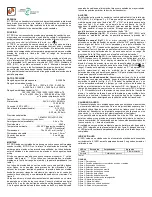
05-3946A01, Rev. C
TransNET OEM Integration Guide
47
HREV
Hardware Revision
Shows the hardware revision of the radio.
KEY
Turn On Radio Transmitter Test Signal
Enables the transmitter. (Radio must be in Setup mode.) See also
DKEY
command (
LED [ON, OFF]
Enable/Disable PCB LEDs
LED ON
enables/disables the PCB board mounted LEDs seen only with the
transceiver’s covers removed.
LED
is normally
OFF
, it may be useful to have
them on for testing the radio with the covers removed. Note: the
external
LEDs will be dimmer if the
LED
function is left
ON
.
The
LED
command also affects the operation of the LEDs in the “Low-Power
Mode” (
LPM
). When
LED
is
OFF
, the radio keeps the
PWR
and
SYNC
LEDs
extinguished.
LPM [1, 0]
Low-Power Mode—Masters Only
This feature trades increased latency to gain power savings. Low-power
mode (LPM) automatically saves power at a Remote by instructing the
Remote to shutdown for large periods of time in between
SYNC
messages.
Master transmissions are automatically blocked while the Remotes are
asleep. Note, both Masters and Remotes are adaptive and will suppress a
normal sleep interval if data transmission or reception is in progress.
•
LPM 1
at the Master enables low-power mode network-wide; all
Remotes pick it up and start saving power by automatically sleeping.
LPM 1
can work in conjunction with the AT dialing feature. The dialed
unit will be forced awake; all others will sleep.
Buffer Mode
OFF
BUFF OFF
Forward Error
Correction
ON
FEC ON
Hop-Time
7 ms
HOPTIME 7
Low-Power Mode
0 (Off)
LPM
Skipped Frequencies
None (radio will hop across all fre-
quencies)
SKIP NONE
Retry Count
10 (max. of 10 repeats for ARQ)
RETRY 10
Repeat Count
3 (downstream repeats)
REPEAT 3
Table 18. INIT Command Generated Defaults
(Continued)
Parameter
Default Setting
Corresponding
Command
















































